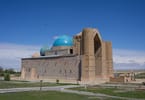A section of the avenue of sphinxes, known among archaeologists as the avenue associated with the Anubieion and the superstructure of an unidentified pyramid, has been found at Cairo’s Saqqara area, said Farouk Hosni, Egypt’s minister of culture. He explained that this avenue was previously mentioned in Roman manuscripts and documents which were unearthed beside the Serapeum, the necropolis of the Apis bulls at Saqqara.
Led by Dr. ZahiHawass, secretary-general of the Supreme Council of Antiquities (SCA), the Egyptian archaeological mission unearthed finds dug out by previous teams. French archaeologist Auguste Mariette found a section of the avenue of sphinxes in 1850. Its western extension led him to the Serapeum. It also extended to the east towards the Anubieion. Hawass revealed another section of the avenue, dated to the Ptolemaic period, was found during recent excavations. It extends to the east, reaching the area of the Nile Valley and the Anubieion’s gate, which was once across the valley.
The mission also discovered a limestone block decorated with inscriptions of Ptolemy V (204-180 BC), which suggests that the newly discovered section of the avenue may be the southern edge of the Anubis temple.
According to Hawass, the superstructure of a pyramid, documented earlier by the German archaeologist Karl Richard Lepsius and given the number XXIX, has also been located. This pyramid was covered with sand for a long time. None of the Egyptologists succeeded in pinning it down until recent excavations uncovered it beside the pyramid of Teti I, first king of the Sixth Dynasty (c. 2374-2354 BC). The entrance of the pyramid, its walls, and burial chamber were also discovered. Inside the burial chamber, a white limestone block was found which may be the northern wall of the chamber, as well as the lid of a sarcophagus and a pit used for the chest containing the canopic jars.
Some Egyptologists believe that the newly-discovered pyramid dates back to the Old Kingdom, while others assign it to the Middle Kingdom. Despite the fact that there is no cartouche giving the name of the pyramid’s owner, Hawass believes that it may belong to King Menkauhor of the Fifth Dynasty.
Meanwhile, three unidentified mummies from Luxor’s west bank were transported on June 2 to the Egyptian Museum, Cairo in Tahrir Square in order to do further scientific studies on their lineage. The SCA revealed that one of the mummies belongs to an unidentified man found during the early twentieth century in the area located in front of King Seti II’s tomb in the Valley of the Kings. Hawass suggested that the mummy may belong to King Thutmose I (c.1525-1516 BC), father of Queen Hatshepsut, as recent analyses have shown that the mummy which bears his name and is on display in the Egyptian Museum does not belong to Seti.
The other mummies belong to unknown females discovered by Giovanni Belzoni in 1817 but they were destroyed during the nineteenth century. They were placed in two coffins for transportation to the Egyptian Museum for further scanning and analysis.
WHAT TO TAKE AWAY FROM THIS ARTICLE:
- Inside the burial chamber, a white limestone block was found which may be the northern wall of the chamber, as well as the lid of a sarcophagus and a pit used for the chest containing the canopic jars.
- The SCA revealed that one of the mummies belongs to an unidentified man found during the early twentieth century in the area located in front of King Seti II's tomb in the Valley of the Kings.
- The mission also discovered a limestone block decorated with inscriptions of Ptolemy V (204-180 BC), which suggests that the newly discovered section of the avenue may be the southern edge of the Anubis temple.






















